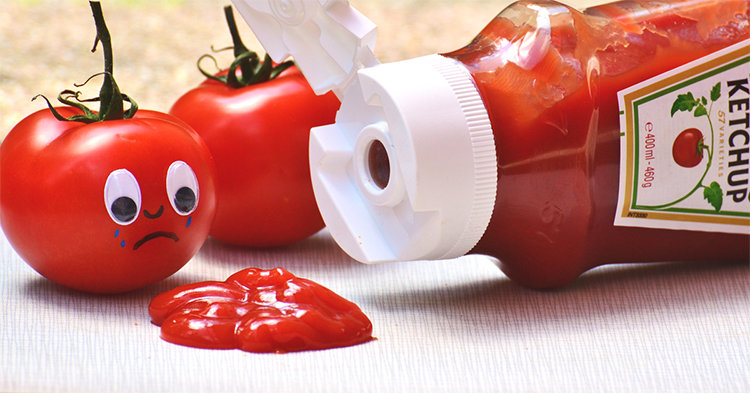
I am a huge fan of dipping sauce. I jokingly... and maybe a little seriously... tell my family that most foods are simply a vessel for sauce. From cucumbers to french fries, I'm more interested in the dip! In the past, I would find that even if I used the correct dose of rapid-acting insulin to cover the food, I would end up confused an hour later with high blood sugar. Once I started paying attention, everything started to make sense. Sugar seems to be hidden everywhere! Did you know there was sugar in Ketchup and Ranch Dressing? Perhaps more surprising than knowing where the sugar is might be how much is there. Here are 5 popular condiments that will raise blood sugar.
Ketchup
One serving (1 TBSP according to most product labels) of ketchup, on average contains 5g of carbohydrate [1]. That means one serving of ketchup has more than one teaspoon of sugar, and the chances of it being high fructose corn syrup are... well, high. To reduce this hidden sugar look for no-sugar-added varieties, like this one from Heinz that is sweetened with sucralose and touts 1g of carbohydrate per serving.
Barbecue Sauce
One serving (2 TBSP) of barbecue sauce, on average, contains 15g of carbohydrates [2]. That's a lot! The total carbs in barbecue sauces vary quite a bit from one brand or style to another. Recently I experimented with how food contamination can affect the accuracy of glucose readings. The barbecue sauce I used contained 18g per serving and just having its residue on my skin had a significant impact on my blood sugar check! If barbecue sauce is your thing, there are low-sugar versions out there, like Guy's Award Winning Sugar-Free Barbecue Sauce. They cost more, of course. So, to save money, try making some at home. Here's a great recipe from Naughty Carbs, touting 7g for a 2 TBSP serving.
Ranch Dressing
One serving (2 TBSP) of ranch dressing, on average, contains 2g of carbohydrate [3]. That doesn't sound like much, and it really isn't if you are just dipping some cucumber slices and don't use up the whole serving. But think about pouring it over that big green salad you ordered for a healthy lunch. Suddenly that salad isn't as low-carb as you thought. While it is okay to add flavor to your meal, remember to count those carbs.
Light Ranch Dressing
Yes, even light dressing. One serving (2 TBSP) of light ranch dressing, on average, contains 4g of carbohydrate [4]. I've seen some as high as 7g. If you get fat-free, you may even see as high as 11g for the same serving size. The thing is, food makers spend a lot on R&D to figure out just the right amount of fat, sodium and sugar to hook people on their products. And, quite frankly, if they removed a significant amount of all three, nobody would buy the products, because they would just be flavorless. When fat is reduced in a dressing the sugar and/or sodium is increased.
Sweet Relish
It's sweet, so no surprises there, right? But how sweet is it? One serving (1 TBSP) of popular brands average 4g of carbohydrate [5]. The spectrum was generally between 3g and 5g for the brands I examined. But what I found most interesting was discovering that dill relish has zero carbohydrates. There are plenty of brands making dill relish. Have you tried it? I have, and I actually prefer it. Give it a try to see if you can enjoy the flavor change.
Remember that having diabetes does not mean you can't enjoy food. I quite enjoy food, myself. The keys to doing this are moderation and mindfulness. Knowing what is in your food, managing portions, substituting and reducing the amount of lower-healthful ingredients can help us improve our eating habits and blood sugar without making mealtime a burden. I know where the sugar is and how it affects me. Now I can choose how much to use on my food vessels.
What is your favorite dipping sauce or condiment? Is it blood sugar friendly?

